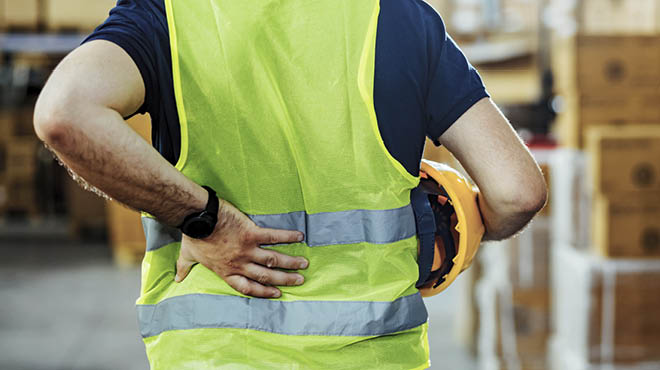Recent Posts
-

-
 Patient StoriesA lifesaver saved: An EMS veteran’s journey from rescue to recoveryNovember 14, 2025
Patient StoriesA lifesaver saved: An EMS veteran’s journey from rescue to recoveryNovember 14, 2025 -

Pain relief for worn spinal disks

The fluid-filled cushions between the bones in your spine are called disks. They provide flexibility, allow for spine movement like flexion and extension, and act as shock absorbers.
Most young people have healthy disks. Each disk is flexible, with fluid-filled collagen fibers that fill the space between the vertebrae and provide the necessary cushion to allow their spines to bend and flex fully without pain.
Disks can wear out with age and use, however, which causes the degeneration and dehydration of the collagen fibers. This is called degenerative disk disease, which usually is a slow degradation of disks over time. Here's what you need to know about this common condition.
Disk anatomy
Understanding the structure or anatomy of disks is essential. There are 23 disks in the spinal column, running from the base of the skull to the tailbone.
Each disk is made up of two parts that work together to absorb and cushion the spine:
- Annulus fibrosus
This is the sturdy yet flexible outer layer of the disk. It forms a ring or circle around the inner core of the disk. - Nucleus pulposus
The center area of each disk is filled with a soft, gel-like substance that acts as the spine's shock absorber.
Degenerative disk disease causes
Multiple factors cause degenerative disk disease, some of which can be controlled and others that cannot.
Age and time increase the odds of developing degenerative disk disease. About 20% of all U.S. adults have some amount of degeneration by age 65. This increases to about 35% by age 80. Sex plays a factor, as females are more likely than males to develop degenerative disk disease.
Contributing factors you can control include excess body weight and spine strain due to manual labor, poor posture and heavy lifting.
Degeneration progression
Everyone has a degree of degeneration with time. It may or may not worsen or cause symptoms. Progression can be slow or fast, or the condition can remain stagnant.
As degenerative disk disease begins, the spinal disks start to lose fluidity. They become dehydrated and are less rubbery or soft. This leads to disk shrinking and a loss of disk height. Often, the disks that are low in the spine degenerate first.
As degeneration progresses further, the disks dry out even more or change shape, known as herniation. When this happens, they may begin pushing on nerves. A person may develop a ruptured or bulging disk.
A bulging disk happens when the outer layer of the disk, the annulus fibrosus, bulges into the spinal canal. A ruptured disk, sometimes called a herniated or slipped disk, happens when the inner part of the disk, the nucleus pulposus, leaks out of the disk through a crack in the annulus fibrosus.
Often, people have a bulging or ruptured disk with no symptoms, but sometimes, this can cause symptoms in one or both legs.
If a disk continues to degrade, it can result in a complete loss of the disk. Then, the person only has an air-filled space between the vertebrae or the bones of two vertebral bodies directly contact each other. A person with this level of progression can experience severe pain, stiffness and possibly nerve compression.
Degenerative disk disease treatment
There are many treatment options for degenerative disk disease. Nonsurgical treatments are crucial throughout the continuum. Weight loss can be highly beneficial, along with decreasing manual labor to reduce stress on the spine. Injections, medications, physical therapy and strengthening your core can ease symptoms.
The majority of degenerative disc disease cases can successfully be treated with conservative treatment, including about 80% of acute radiculopathy, known as sciatica.
Surgical intervention might be an option after nonsurgical treatments are exhausted first. A healthcare professional may recommend surgery if your condition is causing symptoms of nerve compression and these symptoms are progressing despite physical therapy, medications and injections. Symptoms from nerve compression may include pain, numbness or weakness that radiates into a limb. Surgery usually is not a good option for treating solely back pain from osteoarthritis in the spine.
Your healthcare team will explain other circumstances that might warrant surgery, such as when a disc herniation impinges the spinal cord or if there is severe weakness in an extremity, like foot drop.
Surgical options for degenerative disk disease include:
- Decompression surgery, such as a laminectomy or diskectomy, relieves compression of the nerve root for the spinal cord.
- Stabilization surgery, such as a spinal fusion, improves stability by permanently connecting two or more vertebrae in the spine. It may be performed after a decompression surgery in certain cases.
- Disk replacement surgery replaces a worn out disk with an artificial disk. Replacing a disk may help relieve pain in your arms or legs while maintaining motion and flexibility.
Your healthcare team, including experts in pain management, physical medicine and rehabilitation, physical therapy and neurosurgery, will work together to tailor a treatment plan for you.
Next steps:
- Find a neurosurgeon near you.
- Get nine questions to ask your spine surgeon.
- Learn about back pain self-care.
- Read about the common causes of back pain.
By Mayo Clinic Health System staff


